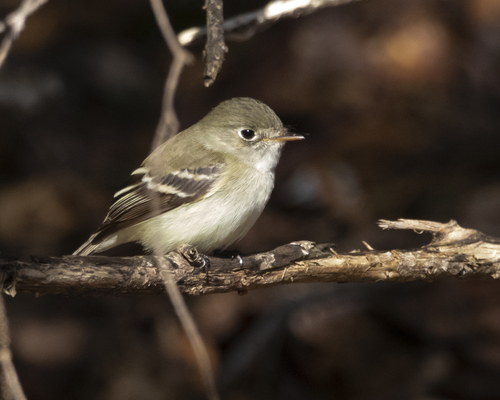
Least Flycatcher
The Least Flycatcher (*Empidonax minimus*) is a small, migratory songbird belonging to the tyrant flycatcher family. It is one of the smallest *Empidonax* flycatchers in North America, known for its distinctive "che-bek" call, which is often heard in its breeding grounds. This species plays a vital role in controlling insect populations within its habitat. While not particularly colorful, its active behavior and vocalizations make it a noticeable presence. It has no particular cultural significance, but it is a welcome sign of spring for birdwatchers.
12-14 cm
Length
18-22 cm
Wingspan
Least Concern
Conservation Status
Distribution
The Least Flycatcher breeds across a broad range of North America, from the eastern slopes of the Rocky Mountains to the Atlantic coast, and from central Canada south to the northern United States. It migrates to Central America and northern South America for the winter, with key wintering areas in Mexico, Guatemala, Honduras, Nicaragua, Costa Rica, and Panama.
Lifespan
Average lifespan in the wild is likely 2-4 years, with a maximum recorded lifespan of around 7 years.
Least Flycatcher's Habitat
Habitat Types
Deciduous forests, Mixed woodlands, Forest edges, Orchards, Parks with scattered trees
Climate Zones
Temperate, Boreal
Adaptations
The Least Flycatcher prefers relatively open deciduous or mixed forests, often near clearings or edges. Its small size allows it to maneuver effectively within dense foliage while hunting insects. Its migratory behavior is an adaptation to seasonal changes in food availability.
Variations
No recognized subspecies.
Appearance
Breeding Plumage
Plumage is generally similar year-round. Breeding birds may have slightly fresher, brighter plumage.
Seasonal Feather Changes
Minimal seasonal variation.
Sex Based Plumage Differences
Males and females have nearly identical plumage: olive-gray upperparts, whitish underparts, two white wingbars, and a faint white eye-ring.
Notable Features
Small size, White eye-ring (often incomplete), Two white wingbars, Short, thin bill
Diet and Feeding
Primary Foods
Small insects, Spiders, Ants, Beetles, Flies, Caterpillars
Foraging Behavior
The Least Flycatcher is primarily an aerial forager. It typically perches on a branch and sallies out to catch flying insects in mid-air. It also gleans insects from foliage.
Specializations
Its small size and agility allow it to capture small, fast-flying insects. The rictal bristles around the base of the bill may aid in insect capture.
Seasonal Diet Variations
Diet is primarily insectivorous throughout the year. During the breeding season, the diet may include a higher proportion of flying insects, while during migration and winter, they may glean more from foliage.
Behavior
Social Structure
Generally solitary or in pairs during the breeding season. May form loose flocks during migration.
Communication
Distinctive "che-bek" song, Sharp "whit" call notes, Wing fluttering during courtship
Migration
The Least Flycatcher is a long-distance migrant, traveling between its breeding grounds in North America and its wintering grounds in Central and northern South America. Migration is primarily nocturnal.
Territorial or Group Behaviors
Males are highly territorial during the breeding season, defending their territories against other males through song and chases.
Conservation
Threats
Habitat loss and degradation (both breeding and wintering grounds), Pesticide use (reducing insect prey), Collisions with buildings and other structures during migration
Protection Programs
Migratory Bird Treaty Act (protects the species in the US and Canada), Conservation efforts aimed at preserving forest habitat
Local National Laws
Protected under the Migratory Bird Treaty Act in the US and Canada.
Population Trend
Stable
Population Estimates
Global population estimated at around 40 million individuals.
Interesting Facts
The Least Flycatcher is one of the earliest spring migrants to arrive on its breeding grounds.
This early arrival allows it to establish territories and begin breeding before many other insectivorous birds arrive.
Males often return to the same breeding territory year after year.
This site fidelity suggests the importance of familiar breeding locations for reproductive success.
They can hover while foraging.
This allows to pick insects from the underside of leaves.
Faqs about Least Flycatcher
What does a Least Flycatcher sound like?
Its most common vocalization is a sharp, emphatic "che-bek" song. It also has a "whit" call note.
Where can I see a Least Flycatcher?
Look for them in deciduous or mixed forests, especially near edges and clearings, during the spring and summer in North America. They are also found in Central America and northern South America during the winter.
How can I tell a Least Flycatcher from other *Empidonax* flycatchers?
The Least Flycatcher is the smallest *Empidonax* flycatcher. Its "che-bek" song is distinctive, and it has a relatively small, pale eye-ring compared to other similar species.
Are Least Flycatchers endangered?
No, Least Flycatchers are currently classified as 'Least Concern' by the IUCN, meaning their population is relatively stable.
Copyright @ Nature Style Limited. All Rights Reserved.
 English
English